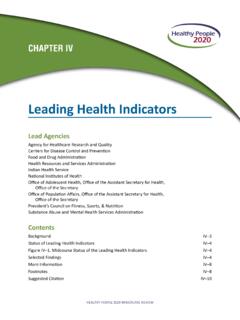Transcription of GLOBAL ACTION PLAN ON PHYSICAL ACTIVITY 2018-2030
1 GLOBAL ACTION plan ON PHYSICAL ACTIVITY 2018-2030 GLOBAL ACTION plan ON PHYSICAL ACTIVITY 2018-2030 GLOBAL ACTION plan on PHYSICAL ACTIVITY 2018 2030: more active people for a healthier worldISBN 978-92-4-151418-7 World Health Organization 2018 Some rights reserved. This work is available under the Creative Commons Attribution-NonCommercial-ShareAlike IGO licence (CC BY-NC-SA IGO; ). Under the terms of this licence, you may copy, redistribute and adapt the work for non-commercial purposes, provided the work is appropriately cited, as indicated below. In any use of this work, there should be no suggestion that WHO endorses any specific organization, products or services. The use of the WHO logo is not permitted. If you adapt the work, then you must license your work under the same or equivalent Creative Commons licence. If you create a translation of this work, you should add the following disclaimer along with the suggested citation: This translation was not created by the World Health Organization (WHO).
2 WHO is not responsible for the content or accuracy of this translation. The original English edition shall be the binding and authentic edition .Any mediation relating to disputes arising under the licence shall be conducted in accordance with the mediation rules of the World Intellectual Property citation. GLOBAL ACTION plan on PHYSICAL ACTIVITY 2018 2030: more active people for a healthier world. Geneva: World Health Organization; 2018. Licence: CC BY-NC-SA (CIP) data. CIP data are available at , rights and licensing. To purchase WHO publications, see To submit requests for commercial use and queries on rights and licensing, see materials. If you wish to reuse material from this work that is attributed to a third party, such as tables, figures or images, it is your responsibility to determine whether permission is needed for that reuse and to obtain permission from the copyright holder.
3 The risk of claims resulting from infringement of any third-party-owned component in the work rests solely with the disclaimers. The designations employed and the presentation of the material in this publication do not imply the expression of any opinion whatsoever on the part of WHO concerning the legal status of any country, territory, city or area or of its authorities, or concerning the delimitation of its frontiers or boundaries. Dotted and dashed lines on maps represent approximate border lines for which there may not yet be full agreement. The mention of specific companies or of certain manufacturers products does not imply that they are endorsed or recommended by WHO in preference to others of a similar nature that are not mentioned. Errors and omissions excepted, the names of proprietary products are distinguished by initial capital reasonable precautions have been taken by WHO to verify the information contained in this publication.
4 However, the published material is being distributed without warranty of any kind, either expressed or implied. The responsibility for the interpretation and use of the material lies with the reader. In no event shall WHO be liable for damages arising from its use. Design and layout:Blossom | in SwitzerlandEXECUTIVE SUMMARY 01. INTRODUCTIONB ackgroundMandateDevelopment process02. WHAT IS PHYSICAL ACTIVITY ?Current levels of PHYSICAL inactivityThe cost of PHYSICAL inactivity to health systems and societyMultiple ways to be active multiple policy choices multiple benefitsPhysical ACTIVITY and the Sustainable Development Goals 2018 2030 Moving forward scaling national action03. THE GLOBAL ACTION plan ON PHYSICAL ACTIVITY 2018 2030 VisionMissionTargetGUIDING PRINCIPLESPARTNERSHIPS FOR ACTIONFRAMEWORK FOR ACTION : 4 STRATEGIC OBJECTIVES, 20 POLICY ACTIONSIMPLEMENTATIONMONITORING AND EVALUATIONR eferencesAPPENDIX 1: PHYSICAL ACTIVITY AND THE SUSTAINABLE DEVELOPMENT GOALSR eferencesAPPENDIX 2: RECOMMENDED POLICY ACTIONS - ROLES FOR STAKEHOLDERSR eferencesAPPENDIX 3: GLOSSARY61212131314151616181920 20202122242542464851616295966 BackgroundRegular PHYSICAL ACTIVITY is proven to help prevent and treat noncommunicable diseases (NCDs) such as heart disease, stroke, diabetes and breast and colon cancer.
5 It also helps to prevent hypertension, overweight and obesity and can improve mental health, quality of life and addition to the multiple health benefits of PHYSICAL ACTIVITY , societies that are more active can generate additional returns on investment including a reduced use of fossil fuels, cleaner air and less congested, safer roads. These outcomes are interconnected with achieving the shared goals, political priorities and ambition of the Sustainable Development Agenda new WHO GLOBAL ACTION plan to promote PHYSICAL ACTIVITY responds to the requests by countries for updated guidance, and a framework of effective and feasible policy actions to increase PHYSICAL ACTIVITY at all levels. It also responds to requests for GLOBAL leadership and stronger regional and national coordination, and the need for a whole-of-society response to achieve a paradigm shift in both supporting and valuing all people being regularly active, according to ability and across the life course.
6 The ACTION plan was developed through a worldwide consultation process involving governments and key stakeholders across multiple sectors including health, sports, transport, urban design, civil society, academia and the private is PHYSICAL ACTIVITY ? PHYSICAL ACTIVITY can be undertaken in many different ways: walking, cycling, sports and active forms of recreation (for example, dance, yoga, tai chi). PHYSICAL ACTIVITY can also be undertaken at work and around the home. All forms of PHYSICAL ACTIVITY can provide health benefits if undertaken regularly and of sufficient duration and current situationGlobal progress to increase PHYSICAL ACTIVITY has been slow, largely due to lack of awareness and , 1 in 4 adults, and 3 in 4 adolescents (aged 11 17 years), do not currently meet the GLOBAL recommendations for PHYSICAL ACTIVITY set by WHO.
7 As countries develop 1 At the seventieth session of the United Nations General Assembly 2015, all countries adopted resolution A/RES/70/1, Transforming our world: the 2030 Agenda for Sustainable , levels of inactivity increase. In some countries, levels of inactivity can be as high as 70%, due to changing patterns of transportation, increased use of technology and urbanization. PHYSICAL ACTIVITY levels are also influenced by cultural values. In most countries, girls, women, older adults, underprivileged groups, and people with disabilities and chronic diseases, all have fewer opportunities to access safe, affordable and appropriate programmes and places in which to be physically active. The GLOBAL cost of PHYSICAL inactivity is estimated to be INT$ 54 billion per year in direct health care, in 2013, with an additional INT$ 14 billion attributable to lost productivity.
8 Inactivity accounts for 1 3% of national health care costs, although this excludes costs associated with mental health and musculoskeletal opportunities: multiple benefitsPhysical ACTIVITY can and should be integrated into the settings in which people live, work and play. Walking and cycling are key means of transportation and enable engagement in regular PHYSICAL ACTIVITY on a daily basis, but their role and popularity is declining in many countries. Sport and active recreation can help promote PHYSICAL ACTIVITY for people of all ages and abilities. Globally it can be a key driver of tourism, employment and infrastructure, and can also help in humanitarian programmes, fostering community development and social integration. PHYSICAL ACTIVITY is important across all ages.
9 Active play and recreation is important for early childhood as well as for healthy growth and development in children and adolescents. Quality PHYSICAL education and supportive school environments can provide PHYSICAL and health literacy for long-lasting healthy, active lifestyles. It is also important that adults can be physically active and less sedentary at work. Whether working or not, older adults, in particular, can benefit from regular PHYSICAL ACTIVITY to maintain PHYSICAL , mental and social health and enable healthy ageing. Primary and secondary health and social care providers can help individuals of all ages become more active and prevent NCDs, while also using PHYSICAL ACTIVITY as a means to increase rates of rehabilitation and recovery. Across all settings there are opportunities for digital innovations to promote and support people of all ages to be more active and to build upon the rapidly growing practice of mHealth to harness the potential of data to help promote , support and monitor PHYSICAL ACTIVITY .
10 PHYSICAL ACTIVITY and the Sustainable Development Goals 2030 Investing in policies to promote walking, cycling, sport, active recreation and play can contribute directly to achieving many of the 2030 Sustainable Development Goals (SDGs). Policy actions on PHYSICAL ACTIVITY have multiplicative health, social and economic benefits, and will directly contribute to achieving SDG3 (good health and well-being), as well as other Goals including SDG2 (ending all forms of malnutrition); SDG4 (quality education); SDG5 (gender equality); SDG8 (decent work and economic growth), SDG9 (industry, innovation and infrastructure); 88 SDG10 (reduced inequalities); SDG11 (sustainable cities and communities); SDG12 (responsible production and consumption); SDG13 (climate ACTION ); SDG15 (life on land); SDG16 (peace, justice and strong institutions) and SDG17 (partnerships).

















